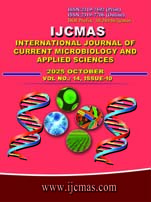


 National Academy of Agricultural Sciences (NAAS)
National Academy of Agricultural Sciences (NAAS)

|
PRINT ISSN : 2319-7692
Online ISSN : 2319-7706 Issues : 12 per year Publisher : Excellent Publishers Email : editorijcmas@gmail.com / submit@ijcmas.com Editor-in-chief: Dr.M.Prakash Index Copernicus ICV 2018: 95.39 NAAS RATING 2020: 5.38 |
The current study investigates the potential of Trigonella foenum greacum L. as a new alternative in terms of natural bioactive components. Fenugreek is abundant in nature and spread over a wide geographical area. It has been a vital part of our Indian Knowledge System for therapeutic treatment. Traditional use often supported by modern studies demonstrates its curative potential in areas like reducing inflammation, glycaemic control, improving cardiovascular markers, lactation, lipid?lowering effects, antioxidant, anti?obesity, anticancer benefits. Various studies have established its medicinal properties like a carminative, gastric stimulant, antidiabetic, galactogogue, hypocholesterolemic, antilipidemia, antioxidant, hepatoprotective, anti-inflammatory, antibacterial, antifungal, antiulcer, anticarcinogenic etc. Still larger and longer clinical studies are essential before broad therapeutic endorsement.
A.M. Flammang, M.A. Cifone, G.L. Erexson, L.F. Stankowski (2004) Genotoxicity testing of a fenugreek extract, Food and Chemical Toxicology, Volume 42, Issue 11, Pages 1769-1775, ISSN 0278-6915, https://doi.org/10.1016/j.fct.2004.07.003.
Abedinzade, M., Nasri, S., Jamal Omodi, M., Ghasemi, E., & Ghorbani, A. (2015). Efficacy of Trigonella foenum-graecum Seed Extract in Reducing Metabolic and Inflammatory Alterations Associated With Menopause. Iranian Red Crescent medical journal, 17(11), e26685, https://doi.org/10.5812/ircmj.26685,
Muhammad H. Alu’datt, Taha Rabbah, Saleh Al-ali, Carole C. Tranchant, Sana Gammoh, Mohammad Alrosan, Stan Kuboy, Thuan-Chew Tan, Salsabeel Ghatasheh, (2024). Current perspectives on fenugreek bioactive compounds and their potential impact on human health: A review of recent insights into functional foods and other high value applications. Journal of food science, 89(4), 1835–1864. https://doi.org/10.1111/1750-3841.16970,
Amr Amin, Aysha Alkaabi, Shamaa Al-Falasi, Sayel A. Daoud, (2005) Chemopreventive activities of Trigonella foenum graecum (Fenugreek) against breast cancer. Cell Biology International, Volume 29, issue 8, Pages 687-694, https://doi.org/10.1016/j.cellbi.2005.04.004,
Awais Ahmad, Salem S. Alghamdi, Kaiser Mahmood, Muhammad Afzal, (2016), Fenugreek a multipurpose crop: Potentialities and improvements, Saudi Journal of Biological Sciences, Volume 23, Issue 2, Pages 300-310, ISSN 1319-562X, https://doi.org/10.1016/j.sjbs.2015.09.015.
Ethan Basch, Catherine Ulbricht, Grace Kuo, Philippe Szapary, Michael Smith, (2003). Therapeutic applications of fenugreek. Alternative Medicine Review: A Journal Of Clinical Therapeutic, 8(1), 20–27.
Bin-Hafeez, B., Haque, R., Parvez, S., Pandey, S., Sayeed, I., & Raisuddin, S. (2003). Immunomodulatory effects of fenugreek (Trigonella foenum graecum L.) extract in mice. International immunopharmacology, 3(2), 257–265. https://doi.org/10.1016/S1567-5769(02)00292-8,
Chaachouay, N., & Zidane, L. (2024). Plant-Derived Natural Products: A Source for Drug Discovery and Development. Drugs and Drug Candidates, 3(1), 184-207. https://doi.org/10.3390/ddc3010011,
Christiane Schulz, Stephan Bielfeldt, Dr. Jürgen Reimann, (2006), Kosmetische MEDIZIN, Fenugreek+micronutrients: Efficacy of a food supplement against hair loss,
Dixit, P., Ghaskadbi, S., Mohan, H., & Devasagayam, T. P. (2005). Antioxidant properties of germinated fenugreek seeds. Phytotherapy research: PTR, 19(11), 977–983. https://doi.org/10.1002/ptr.1769,
Feki, A., Ben Saad, H., Bkhairia, I., Ktari, N., Naifar, M., Boudawara, O., Droguet, M., Magné, C., Nasri, M., & Ben Amara, I. (2019 a). Cardiotoxicity and myocardial infarction-associated DNA damage induced by thiamethoxam in vitro and in vivo: Protective role of Trigonella foenum-graecum seed-derived polysaccharide. Environmental toxicology, 34(3), 271–282. https://doi.org/10.1002/tox.22682,
Feki, A., Jaballi, I., Cherif, B., Ktari, N., Naifar, M., Makni Ayadi, F., Kallel, R., Boudawara, O., Kallel, C., Nasri, M., & Ben Amara, I. (2019 b). Therapeutic potential of polysaccharide extracted from fenugreek seeds against thiamethoxam-induced hepatotoxicity and genotoxicity in Wistar adult rats. Toxicology mechanisms and methods, 29(5), 355–367. https://doi.org/10.1080/15376516.2018.1564949,
Fuller, S., and Stephens, J. M. (2015). Diosgenin, 4-hydroxyisoleucine, and fiber from fenugreek: mechanisms of actions and potential effects on metabolic syndrome. Advances in nutrition (Bethesda, Md.), 6(2), 189–197. https://doi.org/10.3945/an.114.007807,
Ghasemi, V., Kheirkhah, M., & Vahedi, M. (2015). The Effect of Herbal Tea Containing Fenugreek Seed on the Signs of Breast Milk Sufficiency in Iranian Girl Infants. Iranian Red Crescent medical journal, 17(8), e21848. Doi. 10.5812/ircmj.21848,
Gupta, A., Gupta, R., & Lal, B. (2001). Effect of Trigonella foenum-graecum (fenugreek) seeds on glycaemic control and insulin resistance in type 2 diabetes mellitus: a double blind placebo controlled study. The Journal of the Association of Physicians of India, 49, 1057–1061.
Guy Valette, Yves Sauvaire, Jean-Claude Baccou, Gérard Ribes, (1984), Hypocholesterolaemic effect of Fenugreek seeds in dogs, Atherosclerosis, Volume 50, Issue 1, Pages 105-111, ISSN 0021-9150, https://doi.org/10.1016/0021-9150(84)90012-1,
Hannan, J. M., Ali, L., Rokeya, B., Khaleque, J., Akhter, M., Flatt, P. R., & Abdel-Wahab, Y. H. (2007). Soluble dietary fibre fraction of Trigonella foenum-graecum (fenugreek) seed improves glucose homeostasis in animal models of type 1 and type 2 diabetes by delaying carbohydrate digestion and absorption, and enhancing insulin action. The British journal of nutrition, 97(3), 514–521, https://doi.org/10.1017/S0007114507657869,
Kalyan C, NagulapalliVenkata, Anand Swaroop, Debasis Bagchi, Anbupam Bishayee, (2017) Nutrition, Food Research, volume 61, issue 6, Topic: A small plant with big benefits: Fenugreek (Trigonella foenum-graecum Linn.) for disease prevention and health promotion, https://doi.org/10.1002/mnfr.201600950
Katiyar, Chandrakant; Gupta, Arun; Kanjilal, Satyajyoti; Katiyar, Shefali. (2012), Drug discovery from plant sources: An integrated approach. AYU (An International Quarterly Journal of Research in Ayurveda) 33(1):p 10-19, . | https://doi.org/10.4103/0974-8520.100295
Kooshki, A., Khazaei, Z., Rad, M., Zarghi, A., & Mogaddam, A. C. (2018). Effects of fenugreek seed powder on stress-induced hyperglycemia and clinical outcomes in critically ill patients: A randomized clinical trial. Biomedical Research and Therapy, 5(9), 2664-2670. https://doi.org/10.15419/bmrat.v5i9.476
Mounir Ouzir, Khalid El Bairi, Saaïd Amzazi, (2016), Toxicological properties of fenugreek (Trigonella foenum graecum), Food and Chemical Toxicology, Volume 96, Pages 145-154, ISSN 0278-6915, https://doi.org/10.1016/j.fct.2016.08.003.
Muralidhar Meghwal and T. K. Goswami, (2012), A review on the functional properties, nutritional content, medicinal utilization and potential application of Fenugreek, Journal of Food Processing and Technology, 3(9):1-10, DOI:10.4172/2157-7110.1000181,
Nathan, J., Panjwani, S., Mohan, V., Joshi, V., & Thakurdesai, P. A. (2014). Efficacy and safety of standardized extract of Trigonella foenum-graecum L seeds as an adjuvant to L-Dopa in the management of patients with Parkinson's disease. Phytotherapy research: PTR, 28(2), 172–178. DOI: 10.1002/ptr.4969,
Niknam, R., Kiani, H., Mousavi, Z. E., & Mousavi, M. (2021). Extraction, detection, and characterization of various chemical components of Trigonella foenum-graecum L. (fenugreek) known as a valuable seed in agriculture. In Fenugreek: Biology and Applications (pp. 189-217). Singapore: Springer Singapore. https://doi.org/10.1007/978-981-16-1197-1_9,
Udayasekhara Rao, R.D. Sharma, (1987) An evaluation of protein quality of fenugreek seeds (Trigonella foenumgraecum) and their supplementary effects, Food Chemistry, Volume 24, Issue 1, 1987, Pages 1-9, ISSN 0308-8146, https://doi.org/10.1016/0308-8146(87)90078-1,
Ravikumar and C. V. Anuradha, (1999), Phytotherapy Research, volume 13, issue 3, pages- 197-201, Topic: Effect of fenugreek seeds on blood lipid peroxidation and antioxidants in diabetic rats, https://doi.org/10.1002/(SICI)1099-1573(199905)13:33.0.CO;2-L,
Sur, M. Das, A.Gomes, J.R. Vedasiromini, N.P. Sahu, S. Banarjee, R.M. Sharma, D.K. Ganguly, (2001) Phytotherapy Reshearch, issue 3, pages 257-259, Trigonella foenum graecum(fenugreek) seed extract as an antineoplastic agent, https://doi.org/10.1002/ptr.718
Pradeep, S.R., Srinivasan, K. (2018), Alleviation of Cardiac Damage by Dietary Fenugreek (Trigonella foenum-graecum) Seeds is Potentiated by Onion (Allium cepa) in Experimental Diabetic Rats via Blocking Renin–Angiotensin System. Cardiovasc Toxicol 18, 221–231, https://doi.org/10.1007/s12012-017-9431-1,
Pushpa Ruwali, Niharika Pandey, Khusboo Jindal, Rahul Vikram Singh, (2022), Fenugreek (Trigonella foenum-graecum): Nutraceutical values, phytochemical, ethnomedicinal and pharmacological overview, South African Journal of Botany, Volume 151, Part B, Pages 423-431, ISSN 0254-6299, https://doi.org/10.1016/j.sajb.2022.04.014.
Puttaswamy Mujthamba and Krishnapura Srinivasan, (2015), Food and Function, issue 9, Topic- Hypolipidemic influence of dietary fenugreek (Trigonella foenum-graecum) seeds and garlic (Allium sativum) in experimental myocardial infarction, http://dx.doi.org/10.1039/C5FO00240K,
L. R. Reddy and K. Srinivasan. 2009. Dietary fenugreek seed regresses preestablished cholesterol gallstones in mice. Canadian Journal of Physiology and Pharmacology. 87(9): 684-693. https://doi.org/10.1139/Y09-062
K. Kakani, M.M. Anwer, (2012). 16 - Fenugreek, Editor(s): K.V. Peter, In Woodhead Publishing Series in Food Science, Technology and Nutrition, Handbook of Herbs and Spices (Second Edition), Woodhead Publishing, Pages 286-298, ISBN 9780857090393, https://doi.org/10.1533/9780857095671.286,
Roberts K. T. (2011). The potential of fenugreek (Trigonella foenum-graecum) as a functional food and nutraceutical and its effects on glycemia and lipidemia. Journal of medicinal food, 14(12), 1485–1489. https://doi.org/10.1089/jmf.2011.0002,
Sarker, D. K., Ray, P., Dutta, A. K., Rouf, R., & Uddin, S. J. (2024). Antidiabetic potential of fenugreek (Trigonella foenum-graecum): A magic herb for diabetes mellitus. Food Science & Nutrition, 12, 7108-7136. https://doi.org/10.1002/fsn3.4440
Kaviarasan, G.H. Naik, R. Gangabhagirathi, C.V. Anuradha, K.I. Priyadarsini, (2007), In vitro studies on antiradical and antioxidant activities of fenugreek (Trigonella foenum graecum) seeds, Food Chemistry, Volume 103, Issue 1, Pages 31-37, ISSN 0308-8146, https://doi.org/10.1016/j.foodchem.2006.05.064,
Sangita P Patil, Pramod V Niphadkar, Mrinal M Bapat, (1997), Allergy to Fenugreek (Trigonella foenum graecum), Annals of Allergy, Asthma & Immunology, Volume 78, Issue 3, Pages 297-300, ISSN 1081-1206, https://doi.org/10.1016/S1081-1206(10)63185-7.
Sankar, P., Subhashree, S., & Sudharani, S. (2012). Effect of Trigonella foenum-graecum seed powder on the antioxidant levels of high fat diet and low dose streptozotocin induced type II diabetic rats. European review for medical and pharmacological sciences, 16 Suppl 3, 10–17.
Saranya Varadrajan, Thaudur Malapusi Balaji, Malathi Narasimhan, Durai Pandian, Chamudeeswari Meenakshi, Dhanapal Sakhisekaran, (2023), Pharmacological Studies in Natural Oral Care, Chapter 34- Anticancer Activities of Trigonella foenum-graecum L. and Trigonelline on an Oral Squamous Cell Carcinoma Cell Line, Published- 15 September 2023. https://doi.org/10.1002/9781394167197.ch34,
Yves Sauvaire, Gérard Ribes, Jean-Claude Baccou & Marie-Madeleine Loubatieres-Mariani (1991) Implication of steroid saponins and sapogenins in the hypocholesterolemic effect of fenugreek. Lipids 26, 191–197. https://doi.org/10.1007/BF02543970,
Sindhusha, V. B., & Rajasekar, A. (2023). Preparation and Evaluation of Antimicrobial Property and Anti-inflammatory Activity of Fenugreek Gel Against Oral Microbes: An Invitro Study. Cureus, 15(10), e47659. DOI: 10.7759/cureus.47659,
Sreeja, S.; Anju, V.S., (2010), In vitro estrogenic activities of fenugreek Trigonella foenum graecum seeds. Indian Journal of Medical Research 131(6):p 814-819,
Steels, E., Steele, M. L., Harold, M., & Coulson, S. (2017). Efficacy of a Proprietary Trigonella foenum-graecum L. De-Husked Seed Extract in Reducing Menopausal Symptoms in Otherwise Healthy Women: A Double-Blind, Randomized, Placebo-Controlled Study. Phytotherapy research: PTR, 31(9), 1316–1322. https://doi.org/10.1002/ptr.5856,
Sunanda Panda, Sagarika Biswas, Anand Kar, (2013), Trigonelline isolated from fenugreek seed protects against isoproterenol-induced myocardial injury through down-regulation of Hsp27 and αB-crystallin, Nutrition, Volume 29, Issues 11–12, 2013, Pages 1395-1403, ISSN 0899-9007. https://doi.org/10.1016/j.nut.2013.05.006,
Visuvanathan, T., Than, L. T. L., Stanslas, J., Chew, S. Y., & Vellasamy, S. (2022). Revisiting Trigonella foenum-graecum L.: Pharmacology and Therapeutic Potentialities. Plants (Basel, Switzerland), 11(11), 1450. https://doi.org/10.3390/plants11111450,
Volkan Aylanc, Bulent Eskin, Gokhan Zengin, Mehmet Dursun, Yavuz Selim Cakmak, (2020), Topic: In vitro studies on different extracts of fenugreek (Trigonella spruneriana BOISS.): Phytochemical profile, antioxidant activity, and enzyme inhibition potential, Journal of Food and Biochemistry. https://doi.org/10.1111/jfbc.13463,
Wang, Y., Zheng, Y., Liu, Y., Shan, G., Zhang, B., Cai, Q., Lou, J., & Qu, Y. (2023). The lipid-lowering effects of fenugreek gum, hawthorn pectin, and burdock inulin. Frontiers in nutrition, 10, 1149094. https://doi.org/10.3389/fnut.2023.1149094,
Xue, W., Lei, J., Li, X., & Zhang, R. (2011). Trigonella foenum graecum seed extract protects kidney function and morphology in diabetic rats via its antioxidant activity. Nutrition research (New York, N.Y.), 31(7), 555–562. DOI: 10.1016/j.nutres.2011.05.010,
Yadav, U. C., and Baquer, N. Z. (2014). Pharmacological effects of Trigonella foenum-graecum L. in health and disease. Pharmaceutical biology, 52(2), 243–254, DOI: 10.3109/13880209.2013.826247,
Yves Sauvaire, Pierre Petit, Christophe Broca, Michèle Manteghetti, Yves Baissac, Josepha Fernandez-Alvarez, Renè Gross, Michèle Roye, Agnès Leconte, Ramon Gomis, Gèrard Ribes, (1998). 4-Hydroxyisoleucine: A Novel Amino Acid Potentiator of Insulin Secretion. Diabetes, 47 (2): 206–210., https://doi.org/10.2337/diab.47.2.206,
Zameer, S., Najmi, A. K., Vohora, D., & Akhtar, M. (2017). A review on therapeutic potentials of Trigonella foenum graecum (fenugreek) and its chemical constituents in neurological disorders: Complementary roles to its hypolipidemic, hypoglycemic, and antioxidant potential. Nutritional Neuroscience, 21(8), 539–545. https://doi.org/10.1080/1028415X.2017.1327200
Zemzmi, J., Ródenas, L., Blas, E., Najar, T., & Pascual, J. J. (2020). Characterisation and In Vitro Evaluation of Fenugreek (Trigonella foenum-graecum) Seed Gum as a Potential Prebiotic in Growing Rabbit Nutrition. Animals, 10(6), 1041. https://doi.org/10.3390/ani10061041,
 |
 |
 |
 |
 |